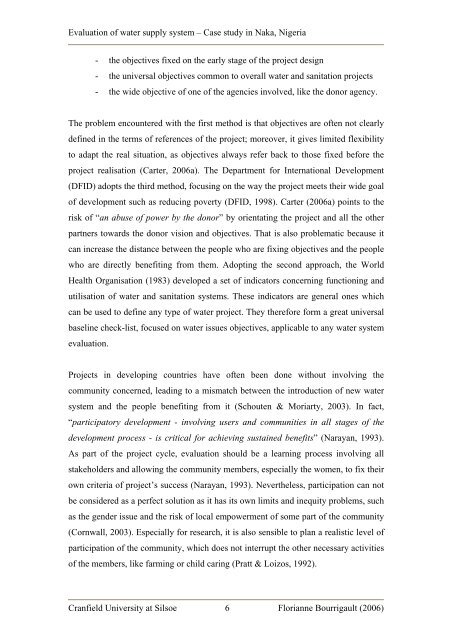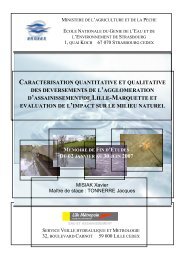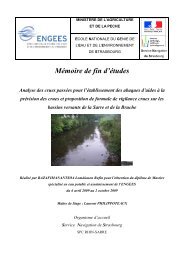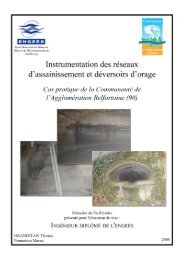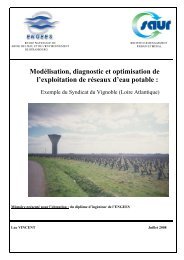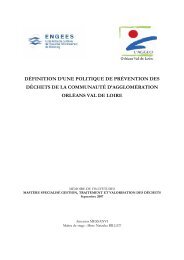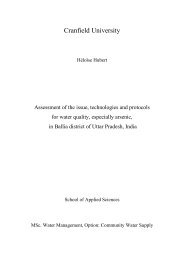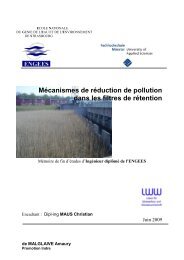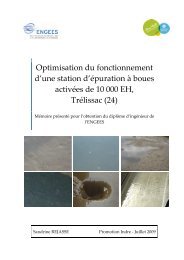Evaluation of water supply system Case study in Naka ... - ENGEES
Evaluation of water supply system Case study in Naka ... - ENGEES
Evaluation of water supply system Case study in Naka ... - ENGEES
- No tags were found...
Create successful ePaper yourself
Turn your PDF publications into a flip-book with our unique Google optimized e-Paper software.
<strong>Evaluation</strong> <strong>of</strong> <strong>water</strong> <strong>supply</strong> <strong>system</strong> – <strong>Case</strong> <strong>study</strong> <strong>in</strong> <strong>Naka</strong>, Nigeria- the objectives fixed on the early stage <strong>of</strong> the project design- the universal objectives common to overall <strong>water</strong> and sanitation projects- the wide objective <strong>of</strong> one <strong>of</strong> the agencies <strong>in</strong>volved, like the donor agency.The problem encountered with the first method is that objectives are <strong>of</strong>ten not clearlydef<strong>in</strong>ed <strong>in</strong> the terms <strong>of</strong> references <strong>of</strong> the project; moreover, it gives limited flexibilityto adapt the real situation, as objectives always refer back to those fixed before theproject realisation (Carter, 2006a). The Department for International Development(DFID) adopts the third method, focus<strong>in</strong>g on the way the project meets their wide goal<strong>of</strong> development such as reduc<strong>in</strong>g poverty (DFID, 1998). Carter (2006a) po<strong>in</strong>ts to therisk <strong>of</strong> “an abuse <strong>of</strong> power by the donor” by orientat<strong>in</strong>g the project and all the otherpartners towards the donor vision and objectives. That is also problematic because itcan <strong>in</strong>crease the distance between the people who are fix<strong>in</strong>g objectives and the peoplewho are directly benefit<strong>in</strong>g from them. Adopt<strong>in</strong>g the second approach, the WorldHealth Organisation (1983) developed a set <strong>of</strong> <strong>in</strong>dicators concern<strong>in</strong>g function<strong>in</strong>g andutilisation <strong>of</strong> <strong>water</strong> and sanitation <strong>system</strong>s. These <strong>in</strong>dicators are general ones whichcan be used to def<strong>in</strong>e any type <strong>of</strong> <strong>water</strong> project. They therefore form a great universalbasel<strong>in</strong>e check-list, focused on <strong>water</strong> issues objectives, applicable to any <strong>water</strong> <strong>system</strong>evaluation.Projects <strong>in</strong> develop<strong>in</strong>g countries have <strong>of</strong>ten been done without <strong>in</strong>volv<strong>in</strong>g thecommunity concerned, lead<strong>in</strong>g to a mismatch between the <strong>in</strong>troduction <strong>of</strong> new <strong>water</strong><strong>system</strong> and the people benefit<strong>in</strong>g from it (Schouten & Moriarty, 2003). In fact,“participatory development - <strong>in</strong>volv<strong>in</strong>g users and communities <strong>in</strong> all stages <strong>of</strong> thedevelopment process - is critical for achiev<strong>in</strong>g susta<strong>in</strong>ed benefits” (Narayan, 1993).As part <strong>of</strong> the project cycle, evaluation should be a learn<strong>in</strong>g process <strong>in</strong>volv<strong>in</strong>g allstakeholders and allow<strong>in</strong>g the community members, especially the women, to fix theirown criteria <strong>of</strong> project’s success (Narayan, 1993). Nevertheless, participation can notbe considered as a perfect solution as it has its own limits and <strong>in</strong>equity problems, suchas the gender issue and the risk <strong>of</strong> local empowerment <strong>of</strong> some part <strong>of</strong> the community(Cornwall, 2003). Especially for research, it is also sensible to plan a realistic level <strong>of</strong>participation <strong>of</strong> the community, which does not <strong>in</strong>terrupt the other necessary activities<strong>of</strong> the members, like farm<strong>in</strong>g or child car<strong>in</strong>g (Pratt & Loizos, 1992).Cranfield University at Silsoe 6 Florianne Bourrigault (2006)


